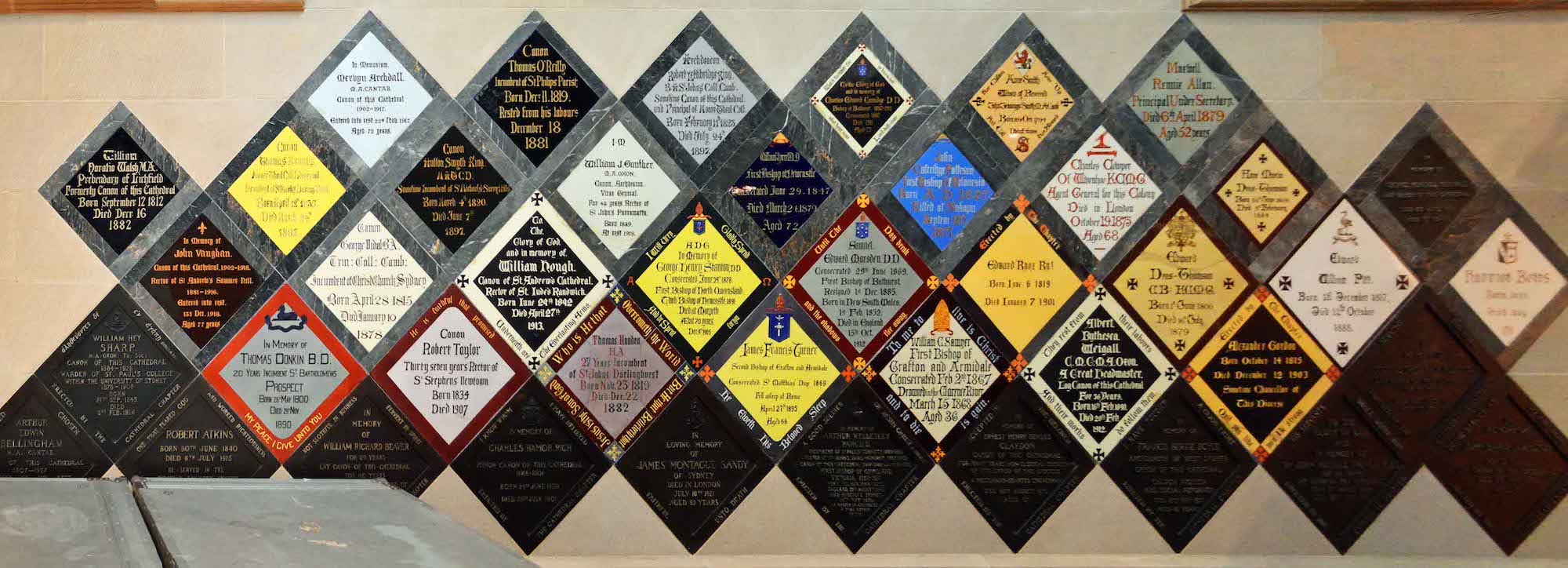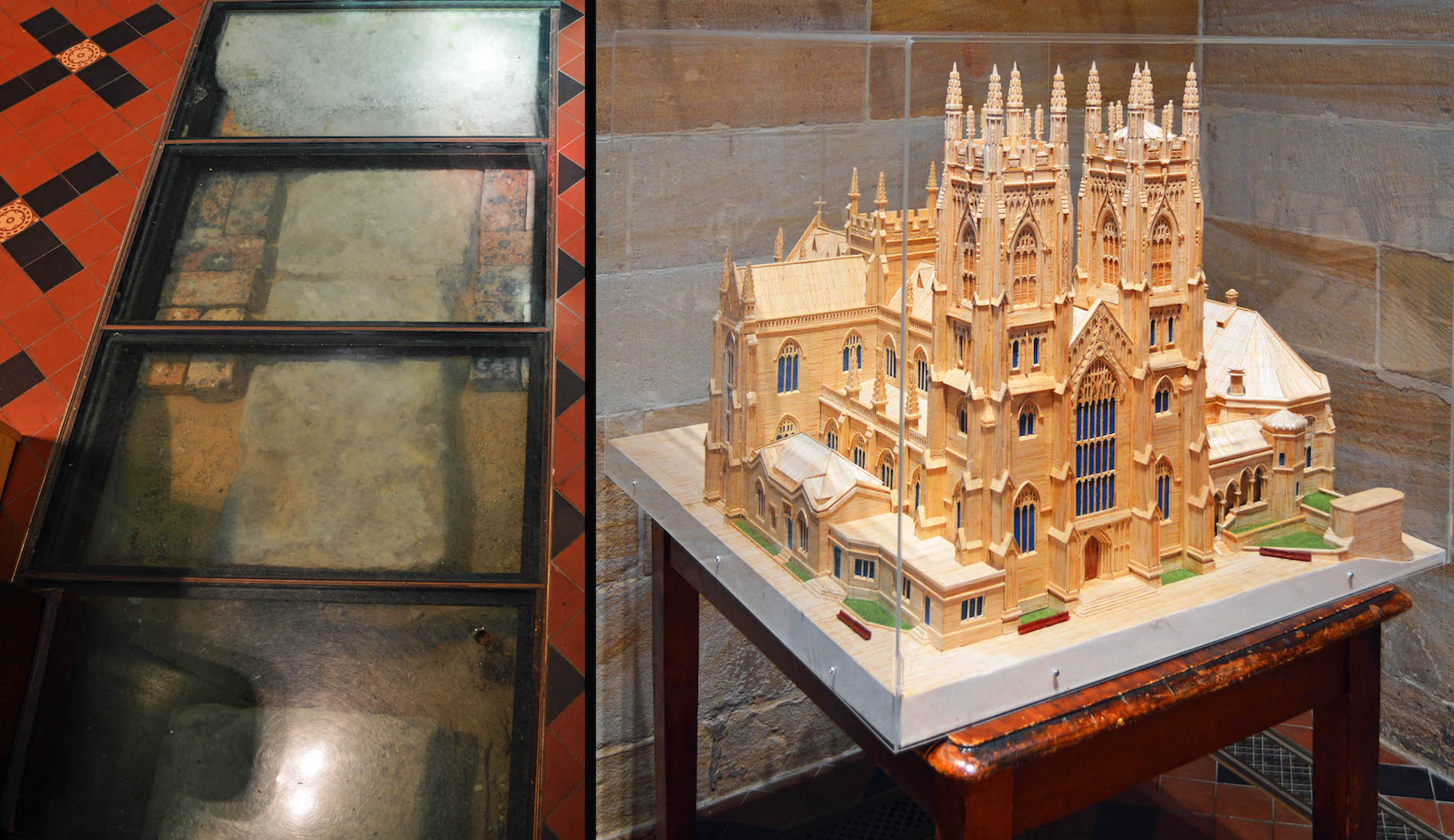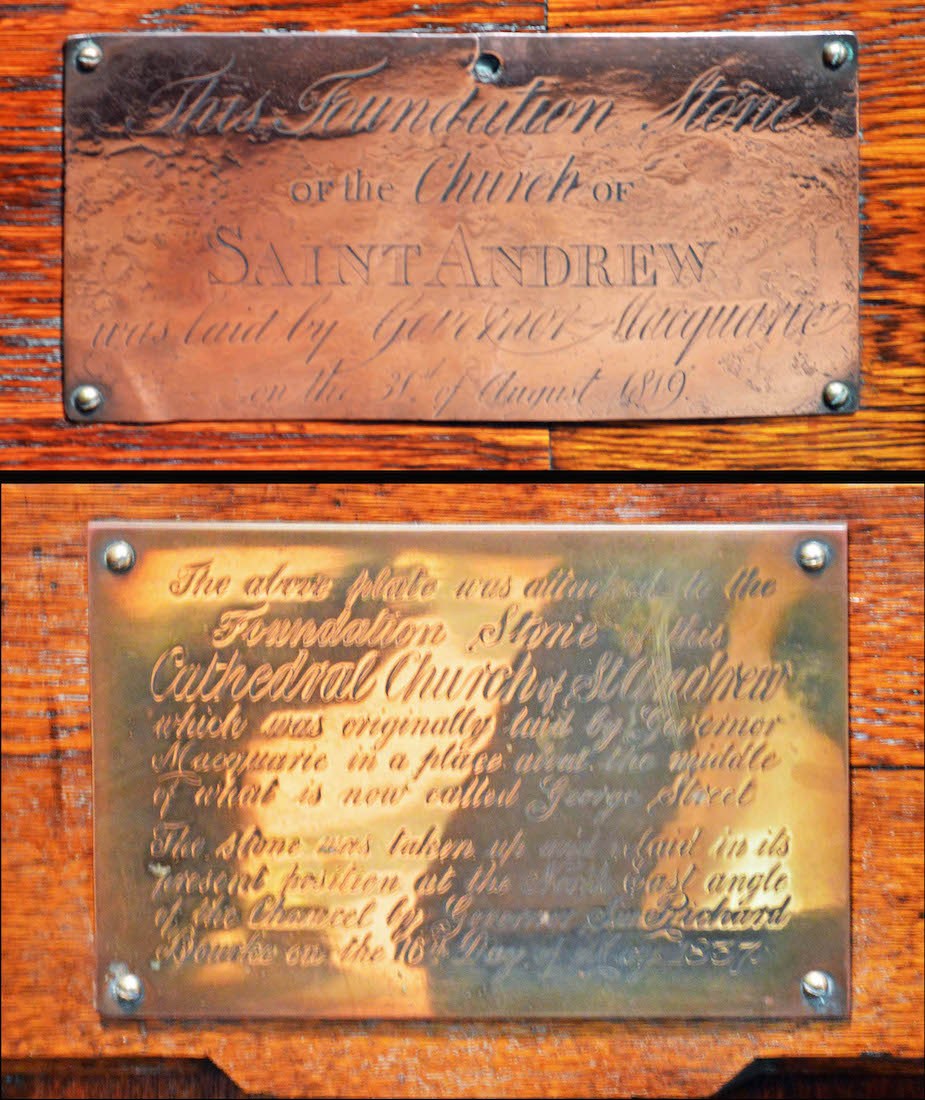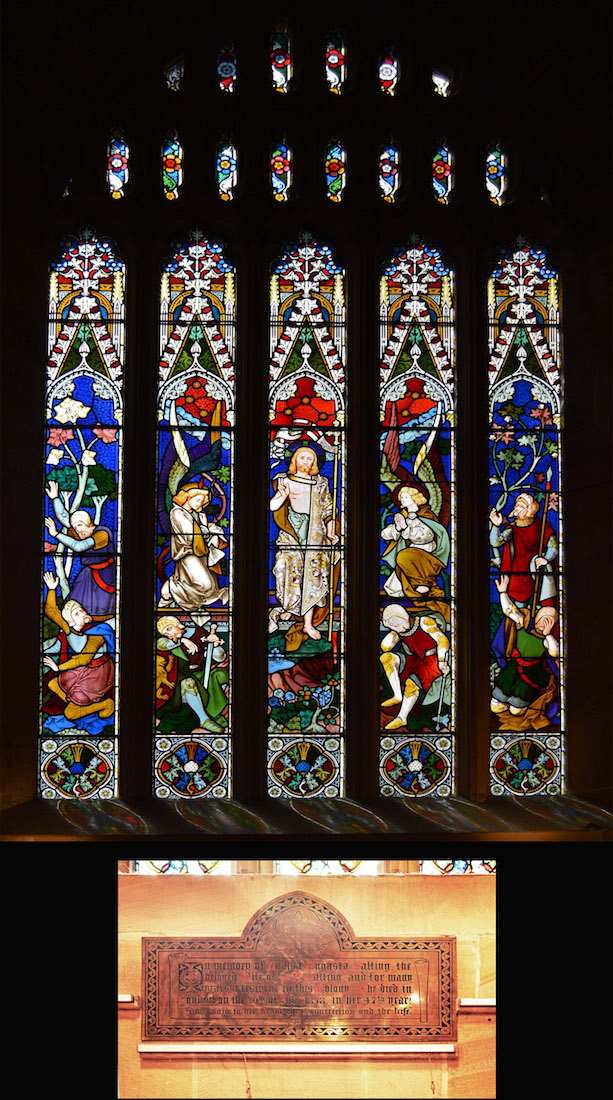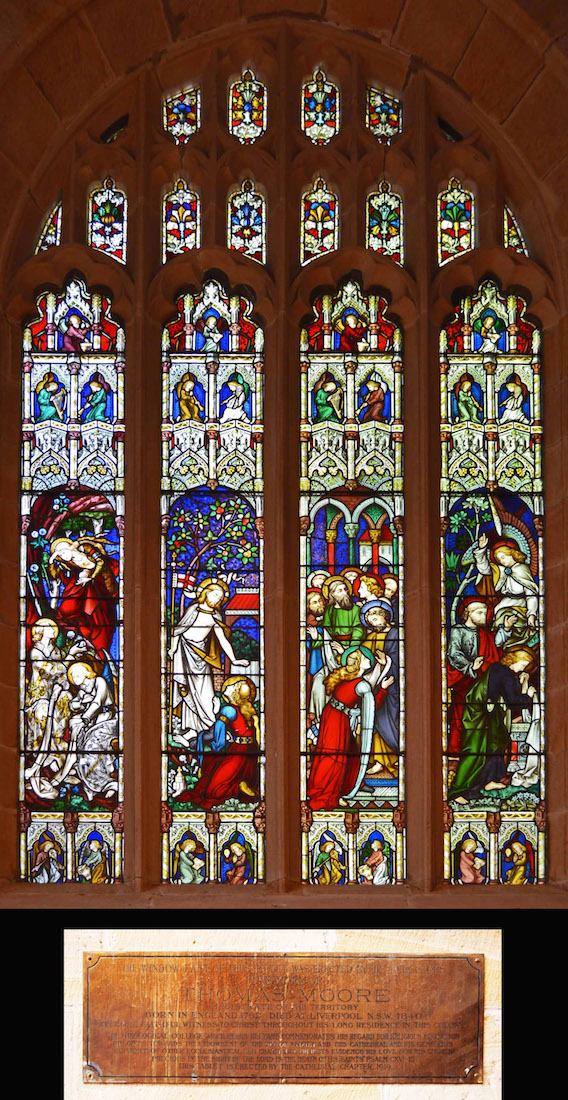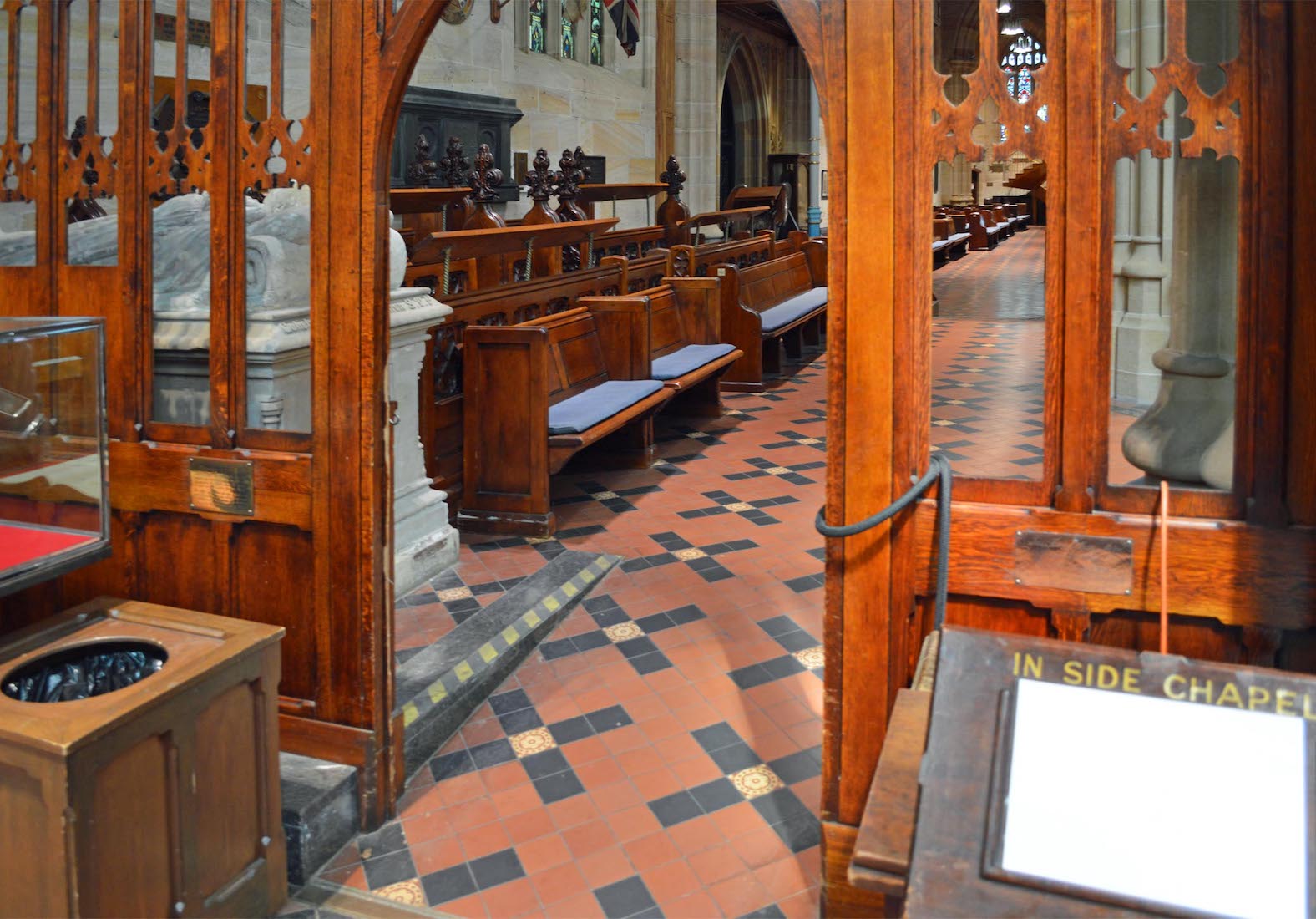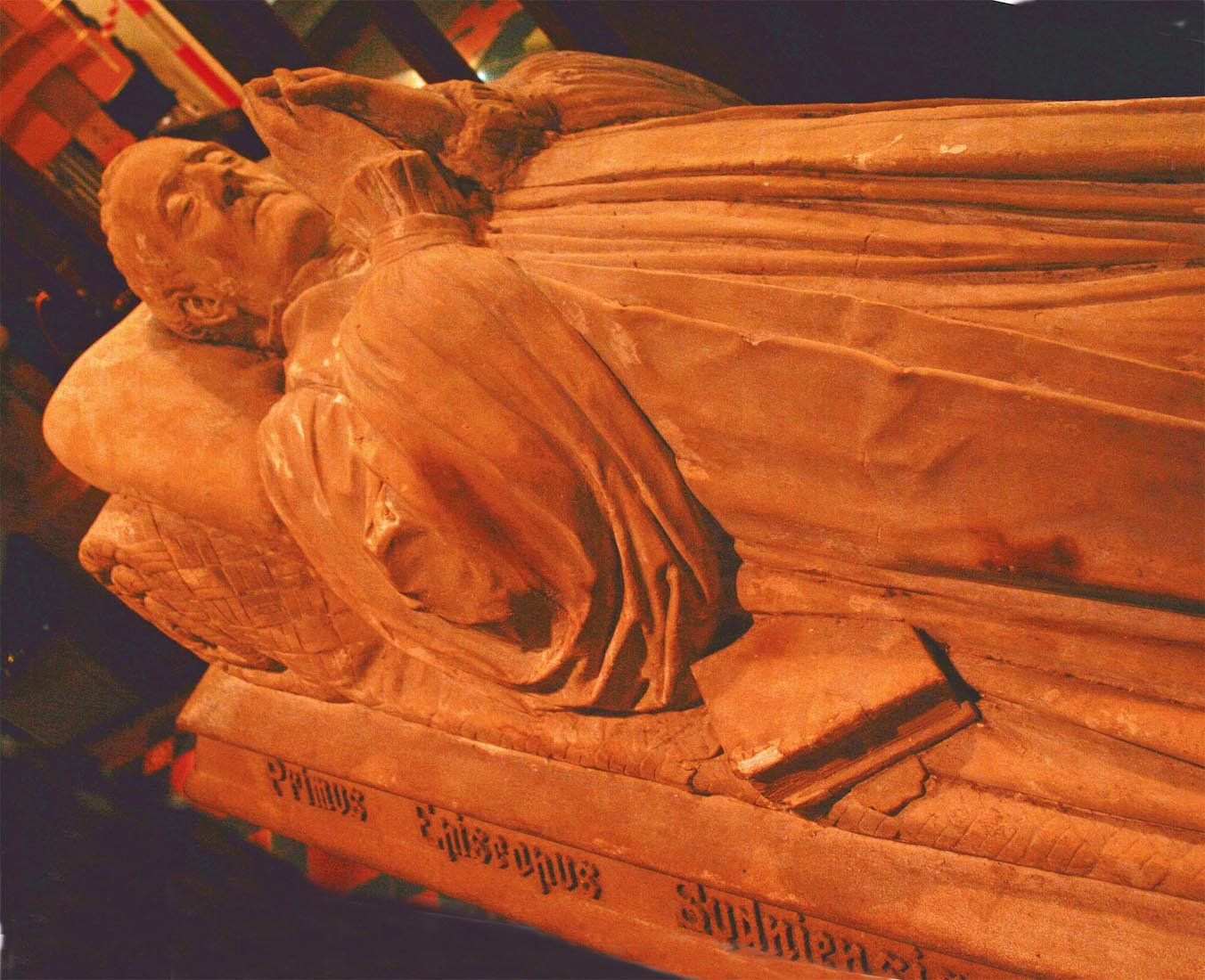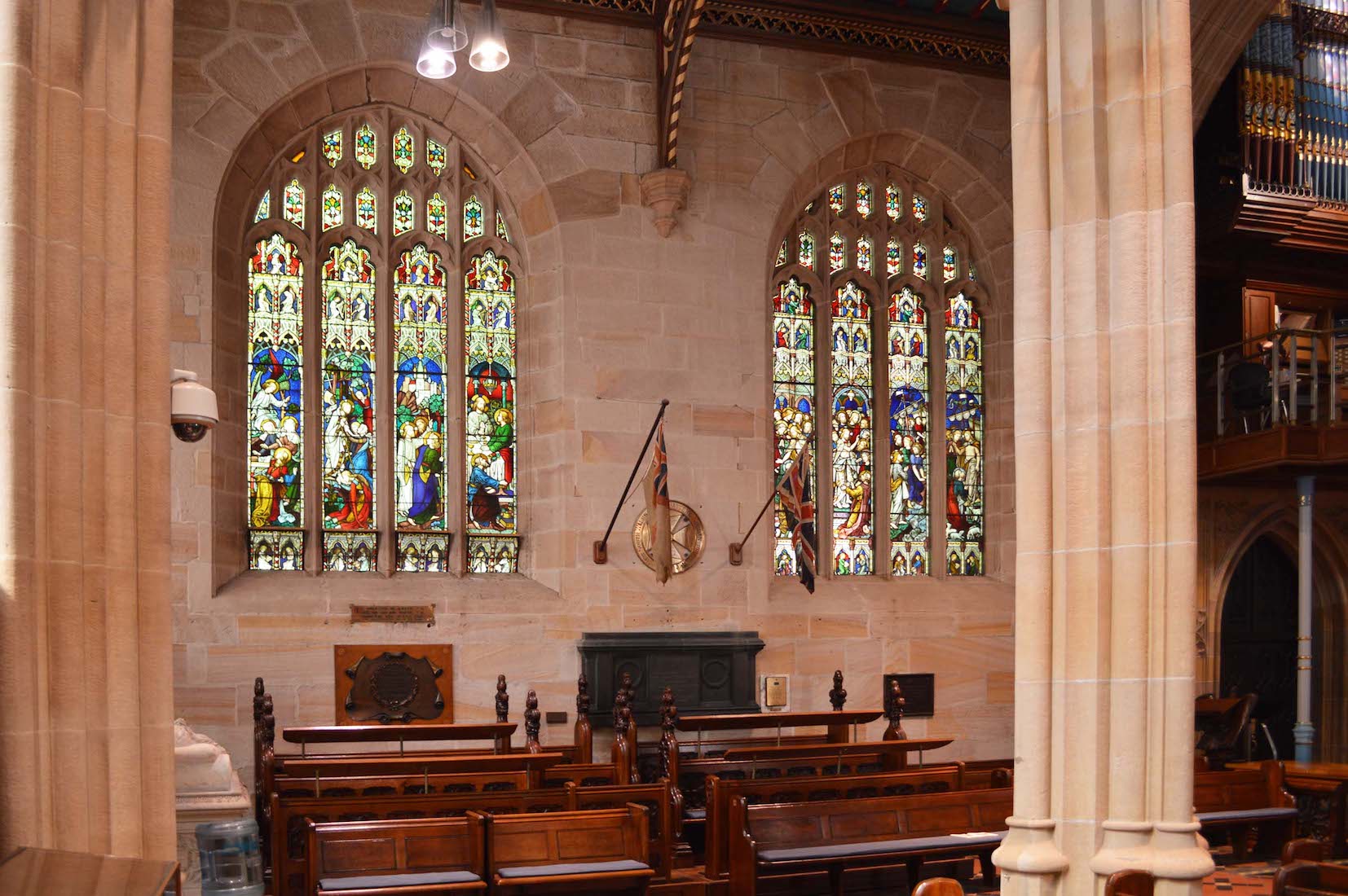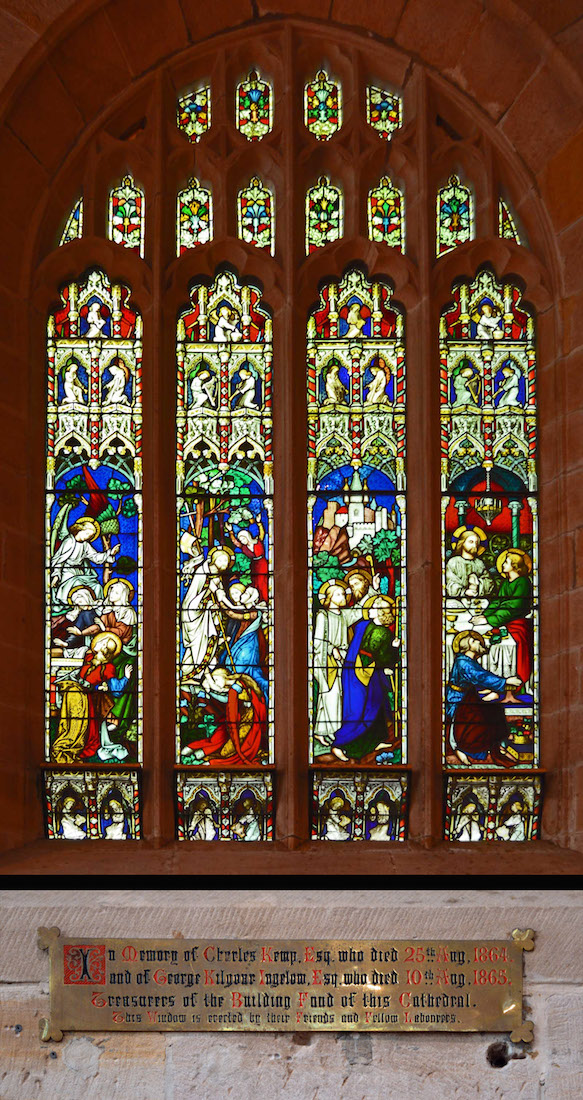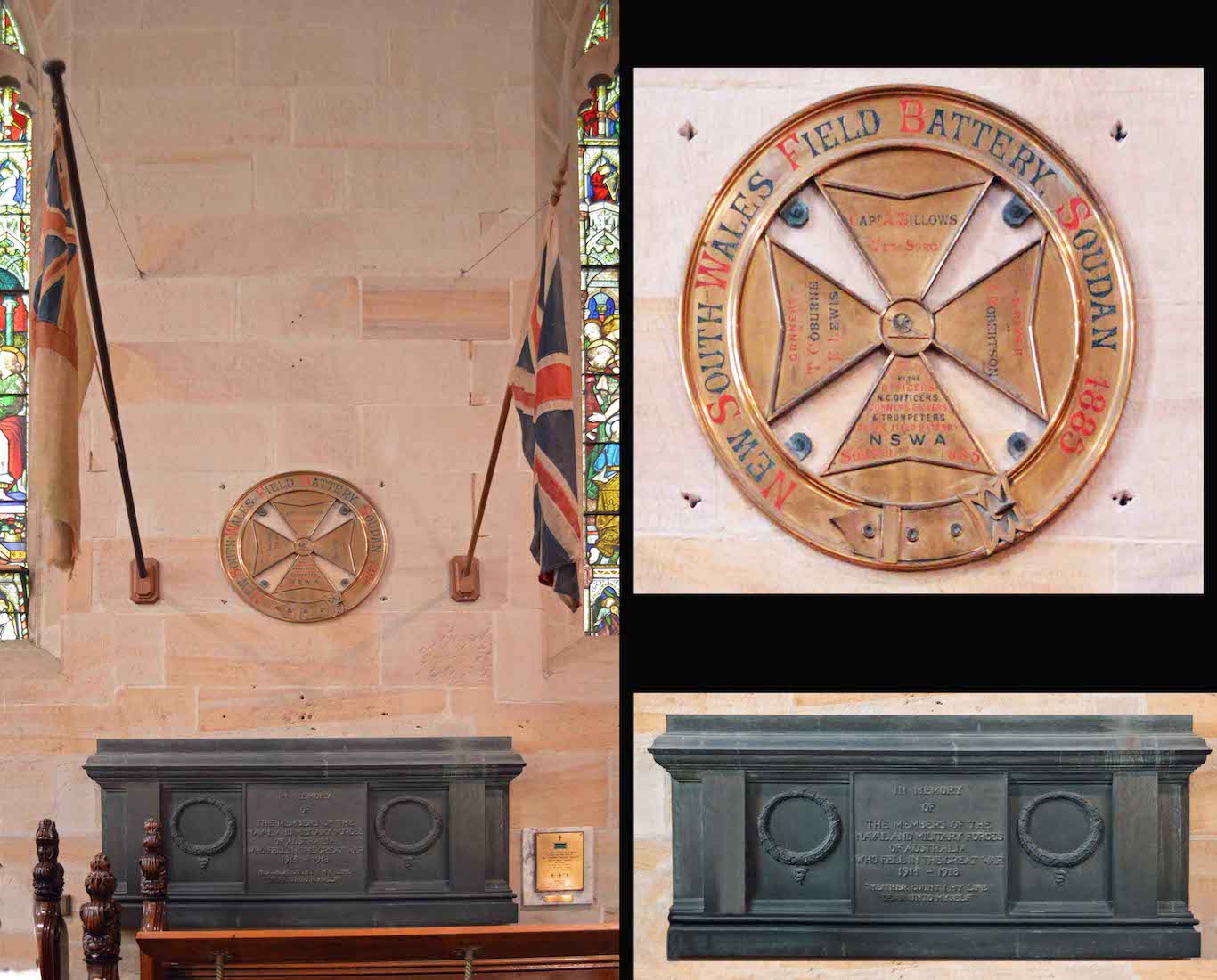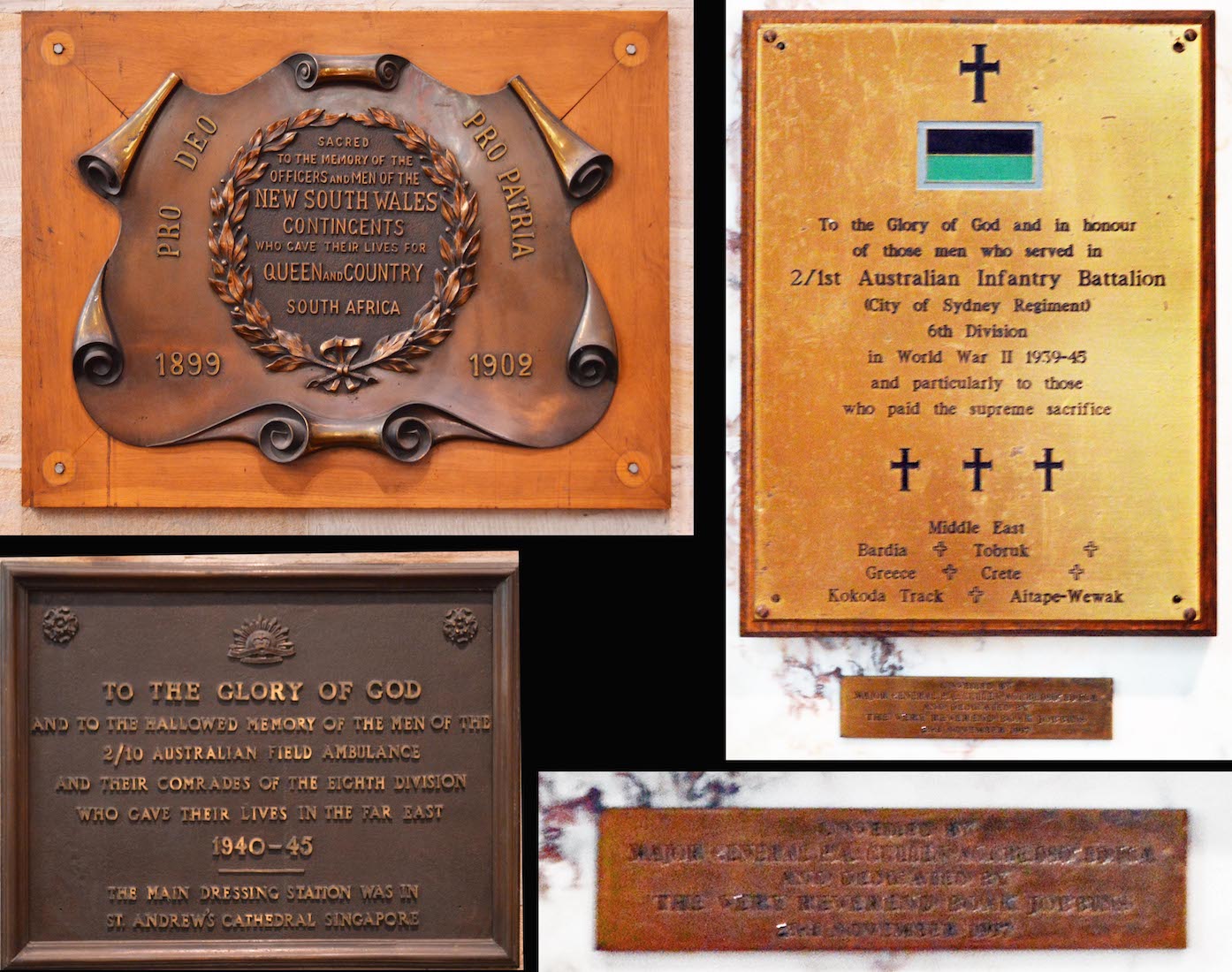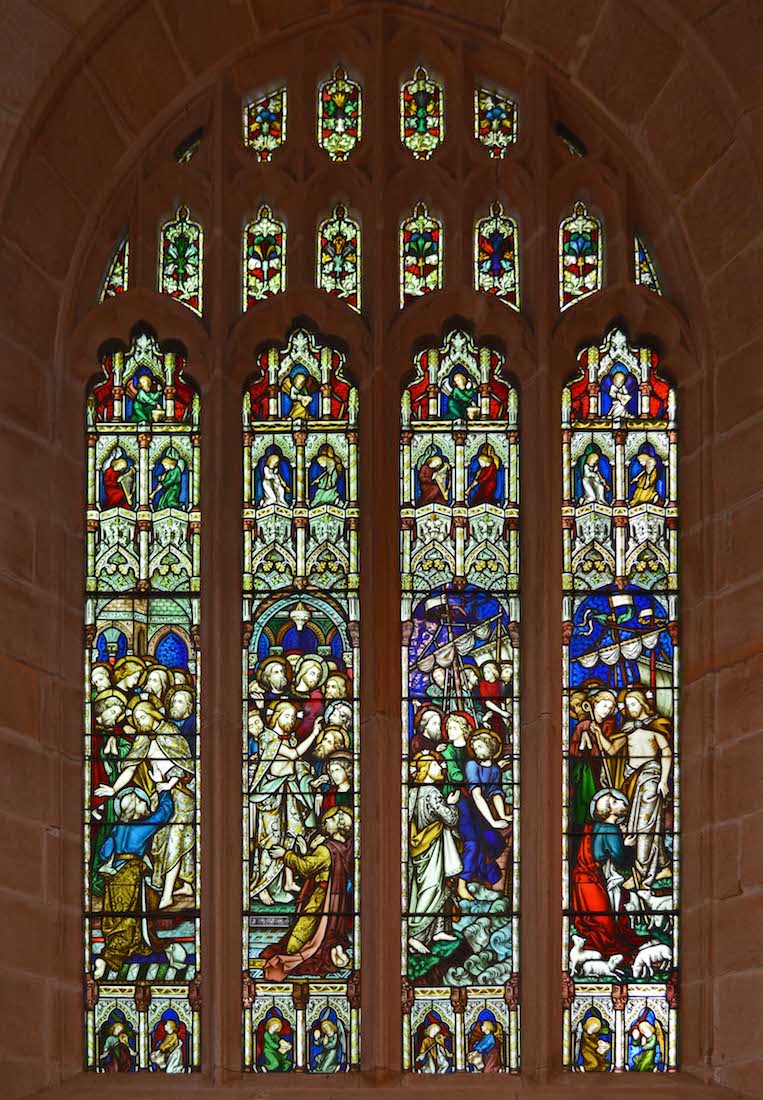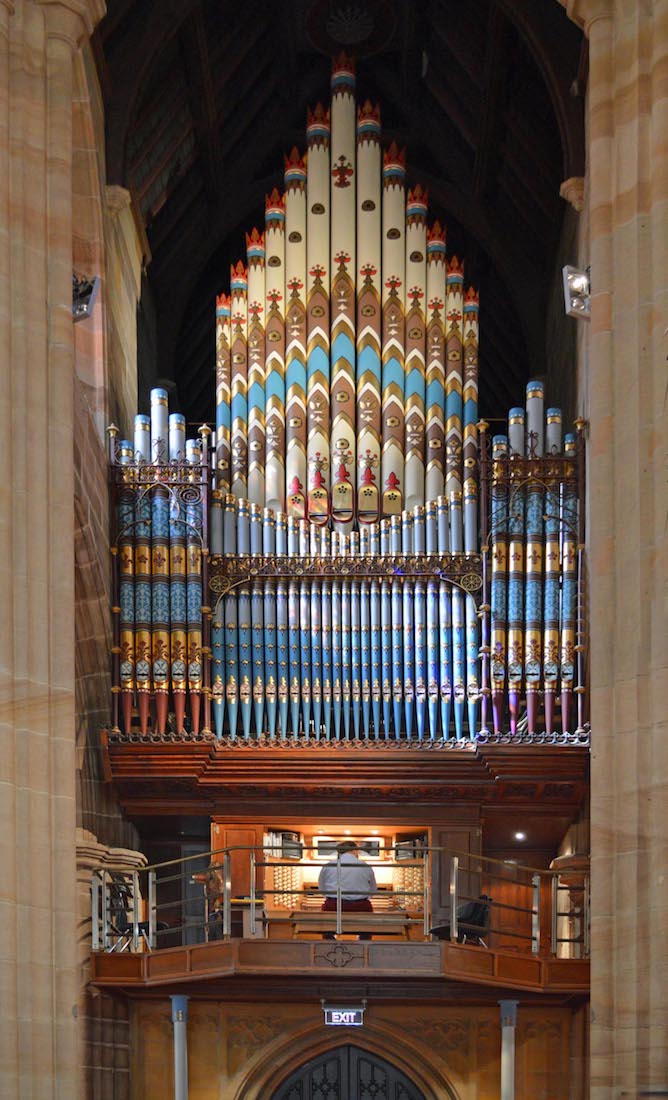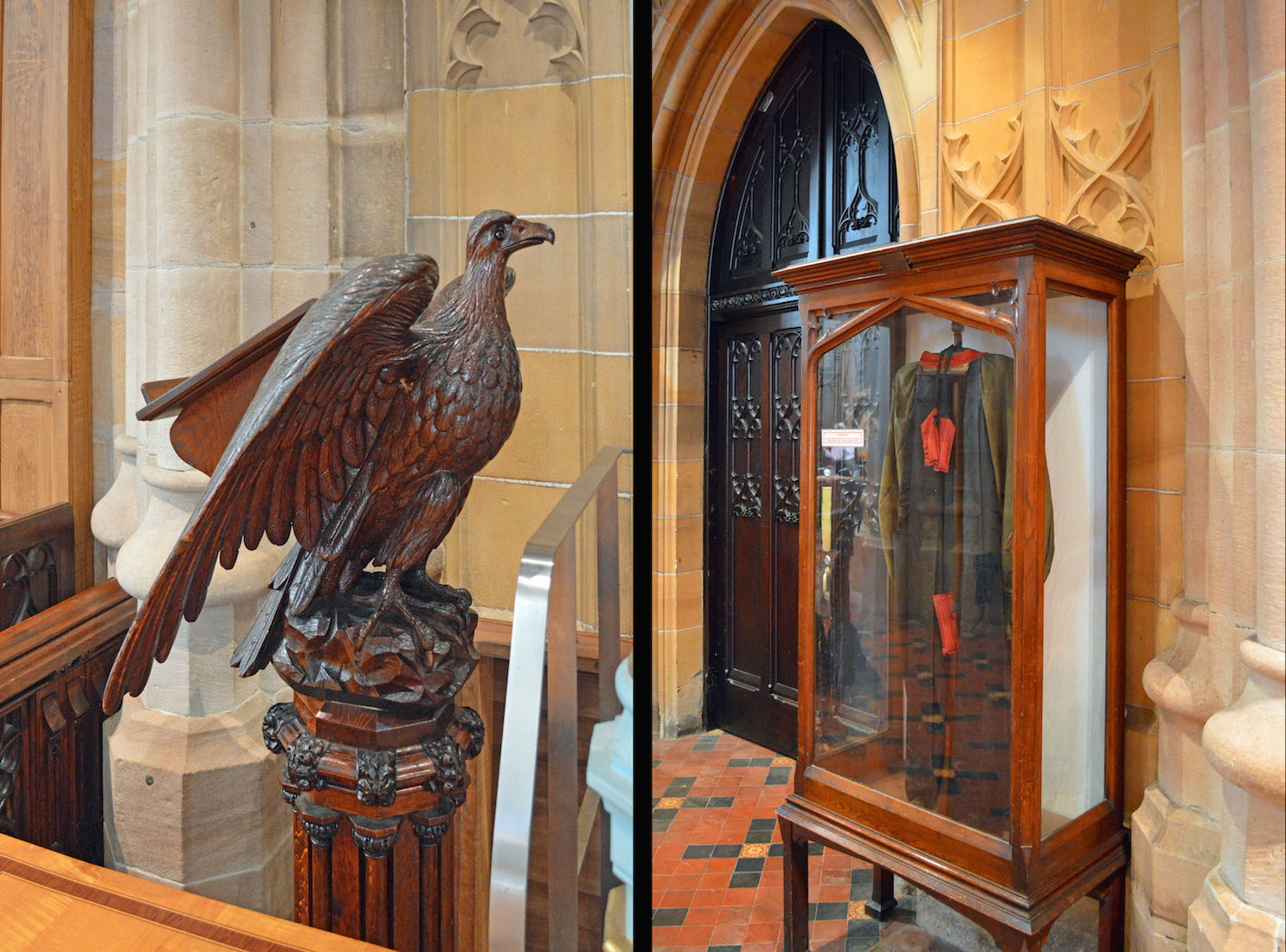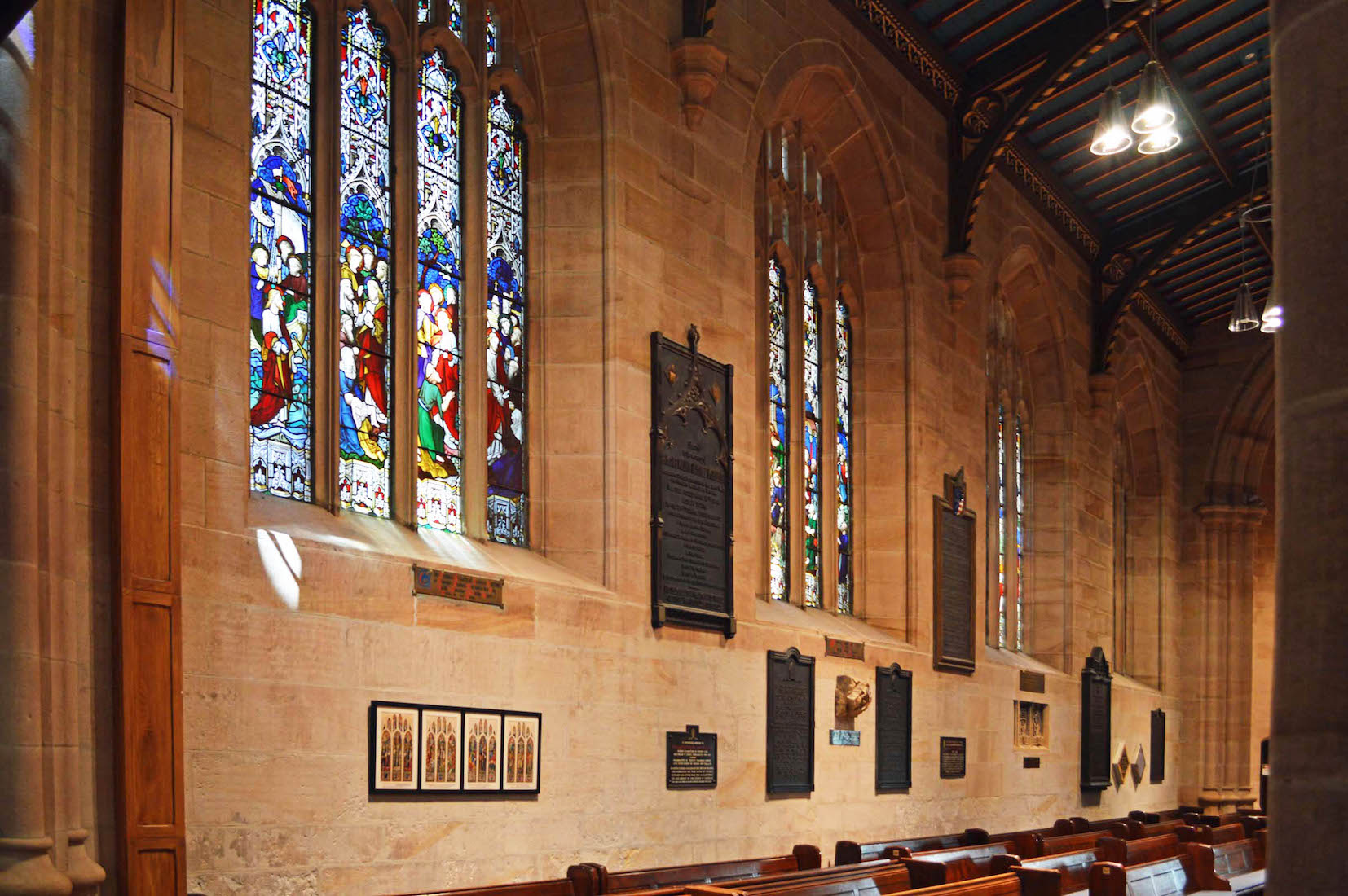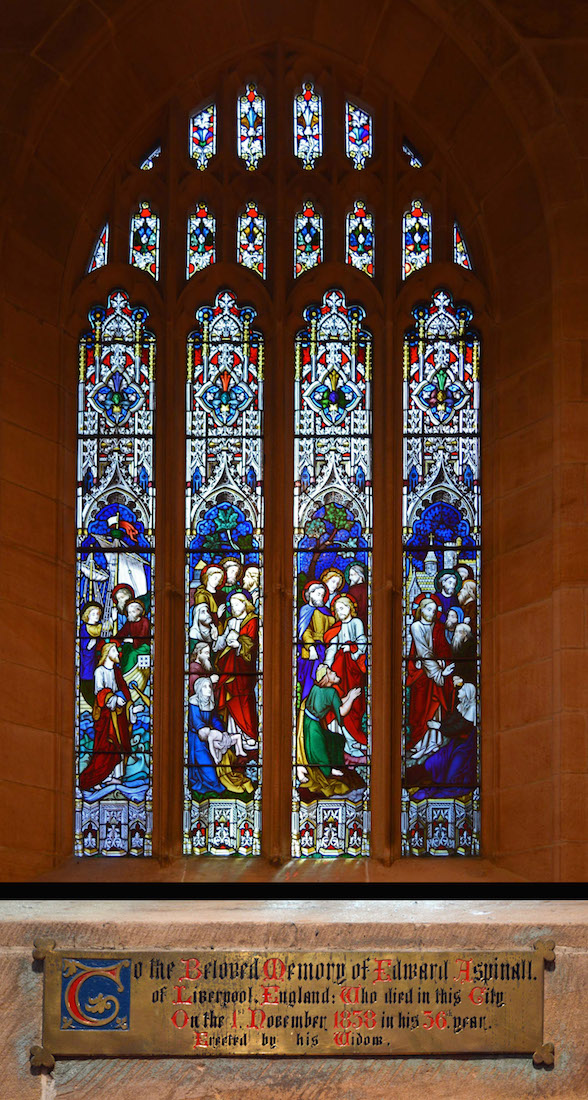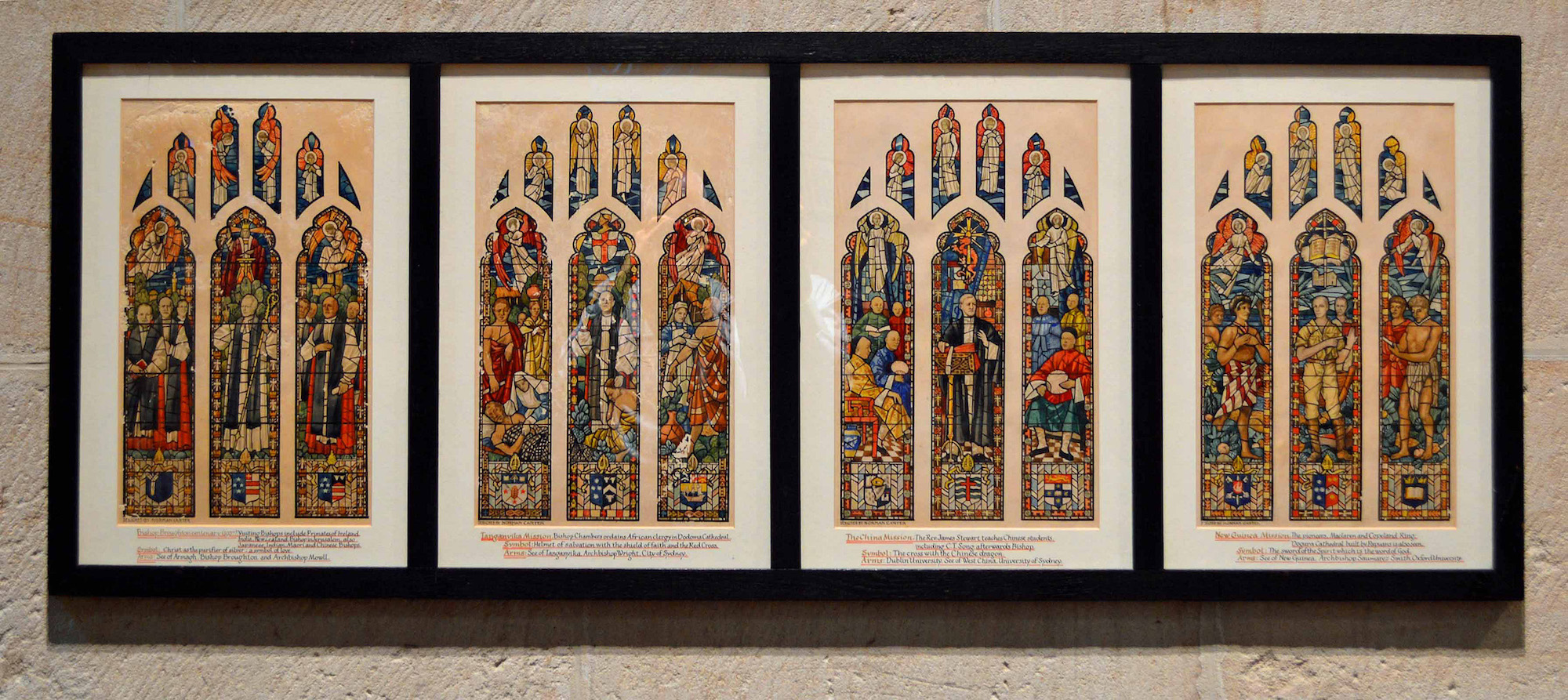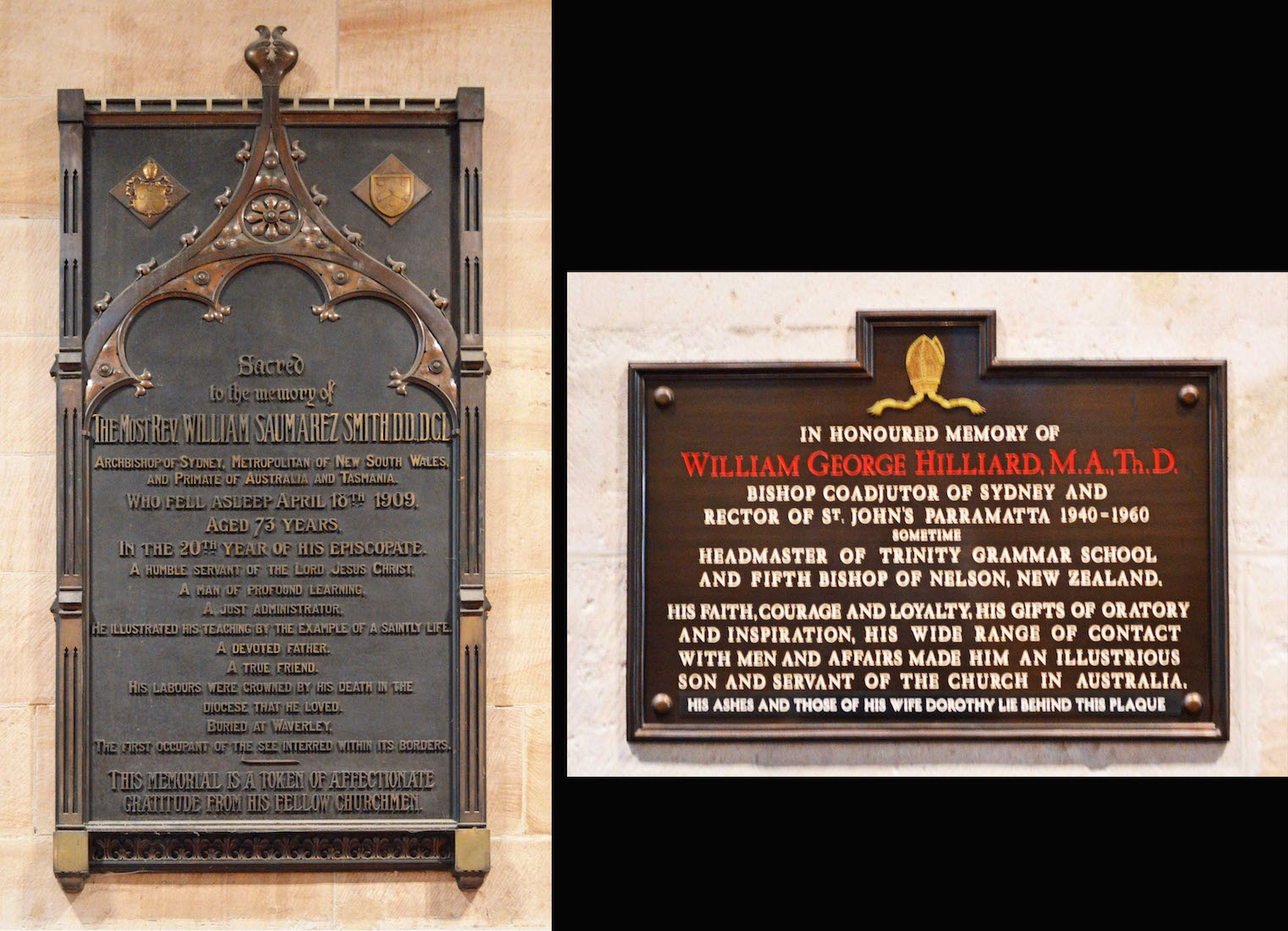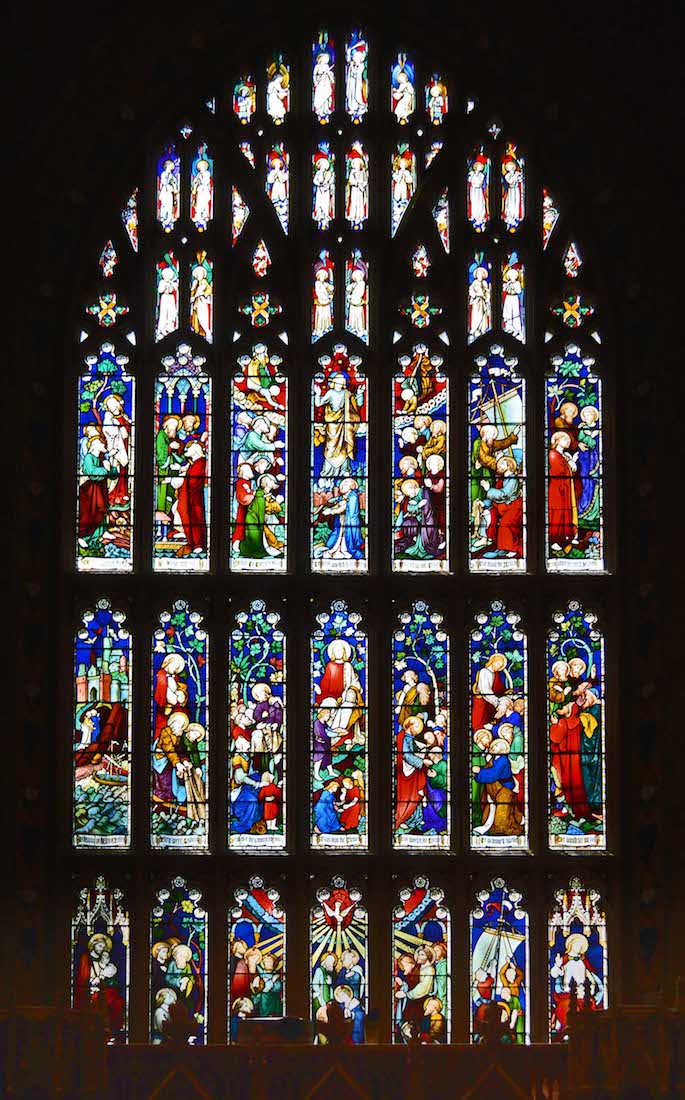
This great East window is one of the largest in Australia. The top tracery makes the window appear as a pair of large windows under a single head. The three principal subjects are (from the bottom) Pentecost, Feeding the 5000, and Jesus Ascending. These are pictured in the central three panels of each tier. Hence in the above enlargement, the three panels at left show the feeding of the crowd. The panel at right shows the Greeks asking to see Jesus. Further details are given in the Cathedral pamphlet. PLAN
42. OLD BIBLE
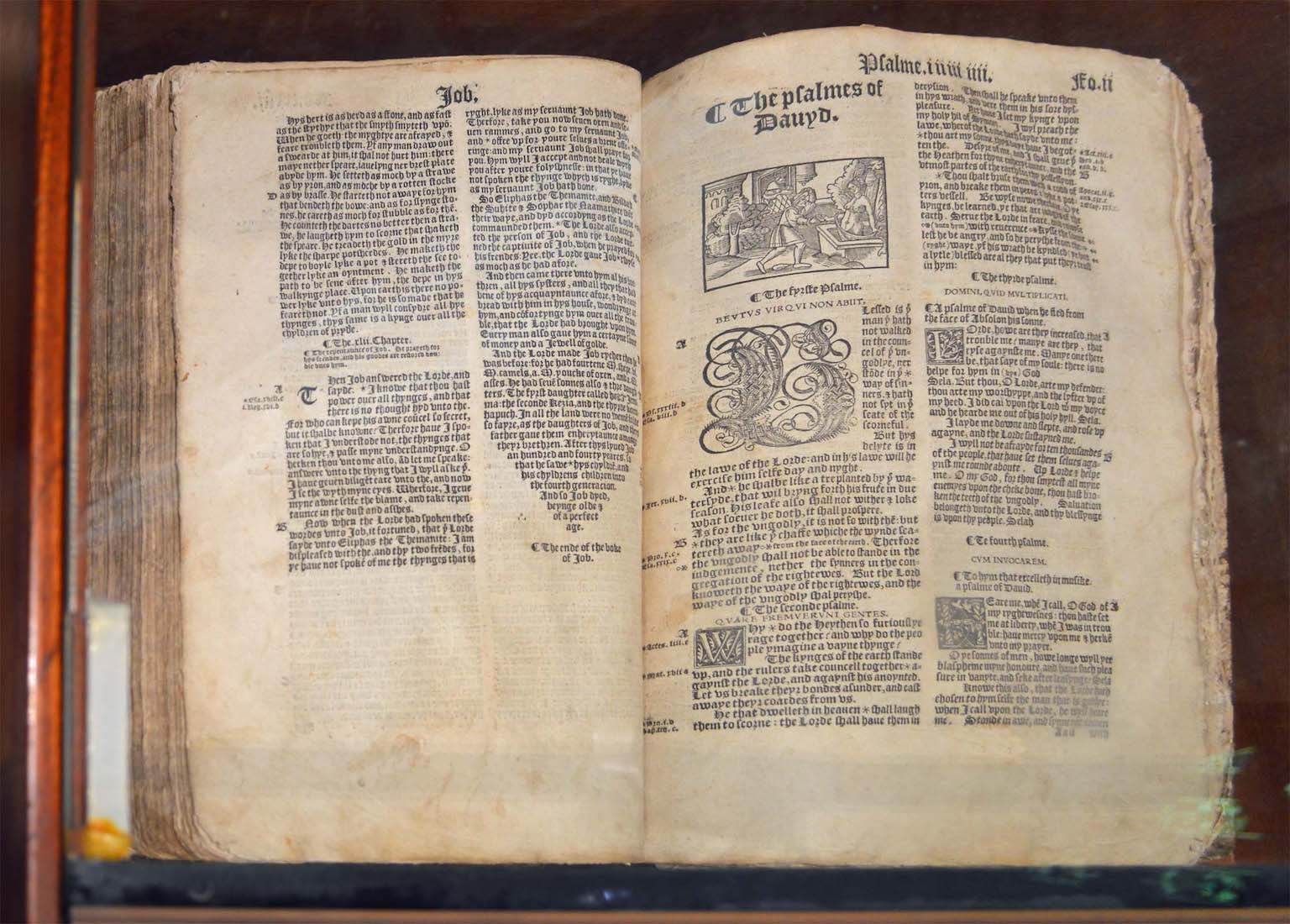
Close to the reredos is a glass case containing a copy of the Great Bible of 1539. The Great Bible was the first authorized edition of the Bible in English, authorized by King Henry VIII of England to be read aloud in the church services of the Church of England. The Great Bible was prepared by Myles Coverdale, working under commission of Thomas, Lord Cromwell, Secretary to Henry VIII and Vicar General. In 1538, Cromwell directed the clergy to provide ‘one book of the bible of the largest volume in English, and the same set up in some convenient place within the said church that ye have care of, whereas your parishioners may most commodiously resort to the same and read it.’
43. MEMORIAL WALL
When I was visiting, the area behind the reredos seemed to be something of a storage area. Behind the various ladders and trolleys is an attractive memorial wall, featuring a tiling of diagonal square tiles. There are many holes and markings in the walls of the Cathedral where memorial tiles were removed during reorientation of the Cathedral in 1941. The memorial tiles are an adaptation of the ancient funerary custom in which the deceased person’s arms (or other symbol) were displayed in church on a diamond-shaped piece of cloth or wood called a hatchment.
44. FOUNDATION, MODEL
In the floor of this East entry area is a glass panel protecting substantial old foundations uncovered during the 1999 restoration of the Cathedral. Also in this entry area is a detailed model of the Cathedral. Such models are wonderful for getting an overall feeling for the Cathedral, and how the component parts fit together.
45. ENTRY PLAQUES
The two plaques are attached to the wall on either side of the doorway between the entry porch and the chancel. One recalls that the foundation stone of St Andrew was laid by Governor Macquarie on the 31st August 1819. The second records that this original foundation stone was removed from what is now the centre of George Street and laid in its present position at the North East angle of the chancel by Governor Sir Richard Bourke on the 16th day of May 1837.
46. CHANCEL EAST WINDOW SOUTH 1
The Southern-most of the three chancel East windows has an Easter morning theme with the risen Christ in the central panel. The plaque below reveals that the window was given in memory of Louisa Augusta Salting, the beloved wife of S. K. Salting, and for many years a resident in this Colony. She died in London on the 20th of July 1858 in her 47th year. It is interesting that these two outer windows (North and South) are in memory of wives.
47. CHANCEL SOUTH WINDOW 1
This is the first window we come to on the South side of the chancel. The theme here is Easter Day as told in John’s gospel. From left to right, the panels show: • Two angels at the tomb, • Jesus and Mary in the garden, • Mary reports she has seen Jesus, • Peter and John at the empty tomb. This window was erected in memory of Thomas Moore, 1762 – 1840, who lived much of his life in the Colony. The Theological College which bears his name commemorates his regard for religious education, his gifts towards the endowment of the See of Sydney and this Cathedral,and his generous support of other ecclesiastical and charitable objects.
48. EAST ENTRY
This is the East entry into the chancel. We note the brass plaques on either side of the doorway – these refer to the foundation stone, as we have seen. Just inside the doorway to the left there is a tomb.
49. BISHOP’S TOMB
William Grant Broughton (1788 – 1853) was the first (and only) Bishop of Australia of the Church of England. (The Diocese of Australia was later divided into a number of smaller dioceses.) Broughton arrived in Sydney in 1829, and was appointed Archdeacon of New South Wales. He was promptly made a member of both the colony's legislative and executive councils. He was enthroned Bishop of Australia in St James' Church, Sydney, as leader of the new Diocese of Australia. He died in London in February 1853 and is buried in Canterbury Cathedral. This is a replica of his tomb.
50. SOUTH CHANCEL
We now turn our attention to the remaining two windows of the South chancel. The Bishop’s tomb is at left, and there is a glimpse of the organ at right. Two flags hang between the windows, and this appears to be a war memorial.
51. CHANCEL SOUTH WINDOW 2
This window also has the theme of Easter Day, but this time relating to the account in the Gospel of Luke. From left to right the panels depict: • Three Marys at the tomb (Luke 24:1–3), • The women see Jesus (Luke 24:4–8; John 20:11 – 18), • Jesus meets the disciples on the Road to Emmaus (Luke 24:13 – 27), • Jesus makes himself known in the meal at Emmaus (Luke 24:28 – 35). This window is given in memory of Charles Kemp Esquire who died 25th August 1864 and of George Kilgour Ingelow Esquire who died 10th August 1865, Treasurers of the Building Fund of this Cathedral.
52. WAR MEMORIAL
Between these windows hang two flags – the Union Jack (right) and the White Ensign (left), the flag flown by ships of the British Navy. A circular plaque is fixed between them. This reads: ‘New South Wales Field Battery Squadron 1885 • Capt A. P. Willows, Vet Surg • Driver, J. Robertson • Gunners T. Coburne, E. Lewis • Erected by the Officers, N.C. Officers, Gunners, Drivers and Trumpeters of the Field Battery N.S.W.A. Squadron 1885. The black tablet reads: ‘In memory of the members of the Naval and Military Forces of Australia who fell in the Great War 1914 – 1918. “Neither count I my life dear unto myself.” ’
53. CHANCEL SOUTH PLAQUES
These three main plaques read • Pro Deo pro Patria 1899 – 1902 Sacred to the memory of the officers and men of the New South Wales contingents who gave their lives for Queen and country South Africa • To the glory of God and to the hallowed memory of the men of the 2/10 Australian Field Ambulance and their comrades of the Eighth Division who gave their lives in the Far East 1940 – 45. • To the glory of God and in honour of those men who served in 2/1st Australian Infantry Battalion (City of Sydney Regiment) 6th Division in world War II 1939 – 1945 and particularly to those who paid the supreme sacrifice Middle East Bardia Tobruk Greece Crete Kokoda Trail Altape-Wewak.
54. CHANCEL SOUTH WINDOW 3
The window just West of the flags shows Christ with his disciples. From left to right: • Jesus shows his wounds to Thomas (John 20:27), • Thomas believes (John 20:28), • In Galilee, Jesus tells his followers where to fish (John 21:4–6), • Jesus tells Peter, “Feed my sheep” (John 21:15 – 17).
55. ORGAN, SOUTH TRANSEPT
What a beautiful sight! In 1866 an organ by the prominent English organ builders William Hill & Sons was installed with a case to Edmund Blackett's design and richly decorated organ pipes. It was placed in the South transept. In 1932 an organ by John Whitely was placed opposite in the North transept. The instruments were amalgamated to be played from a single console in the 1950s, and further rationalized in 1998. The Whitely was removed from the North transept gallery. The organ, as reconstituted by Letourneau, consists of four manuals with mechanical action, comprising the rebuilt Hill organ, together with the best of the Whitely pipework.
56. EAGLE, SOUTH TRANSEPT WEST WALL
The glass display case at right stands in the South transept, and nearby is this fine wooden carved eagle lectern. The Anglican Church has a long tradition of lecterns in the form of a flying eagle. This eagle is the symbol of John the Evangelist (see Revelation, 4:7) who proclaimed Christ as 'the Word of God' at the beginning of his Gospel. The flying eagle is thus a suitable emblem from which God's Word is read, reaching the ends of the earth. The eagle is also thought of as the bird which flies nearest to heaven. This lectern is a memorial to Bishop Barry, the third Bishop of Sydney and founder of St Andrew’s Cathedral School.
57. NAVE SOUTH WALL
We now survey the South wall of the nave, West of the transept. Here there are four more large windows, and many plaques and memorials. The windows seen here have a common theme of the miracles performed by Jesus.
58. SOUTH NAVE WINDOW 1
The miracles depicted in window 9 are (from left to right): • Walking on water (Matthew 14:25 – 30), • Healing on the Sabbath (Luke 13:10 – 17), • Curing a leper (Luke 17:11 – 19), • Curing a sick woman (Mark 5:25 – 34). The window was erected by the widow of Edward Aspinall of Liverpool, England, in memory of her husband who died in Sydney on the 1st December 1858 in his 56th year.
59. CLERESTORY STRIP
This strip gives information on the nave North clerestory window (albeit in reverse order!). From left to right: Windows R, Q: Bishop Broughton Centenary (1937) Visiting Bishops include Primates of Ireland, India, NZ, Bishop in Jerusalem, also Japanese, Indian, Maori and Chinese Bishops; Tanganyika Mission – Bishop Chambers ordains African clergy in Dodoma Cathedral. Windows P, O: The China Mission The Rev James Stewart teaches Chinese students including C. T. Song, afterwards Bishop; New Guinea Mission The pioneers Maclaren and Copeland King. Dogura cathedral built by Papuans is also shown.
60. SOUTH NAVE PLAQUES
These two plaques read: • Sacred to the memory of The Most Rev William Saumarez Smith DD, DCL, Archbishop of Sydney, Metropolitan of NSW, and Primate of Australia and Tasmania, who fell asleep April 18th 1909 aged 73 years in the 20th year of his Episcopate ... • In honoured memory of William George Hilliard MA Th D, Bishop Coadjutor of Sydney and Rector of St John’s Parramatta 1940 – 1960, sometime Headmaster of Trinity Grammar School and Fifth Bishop of Nelson, New Zealand. ...


